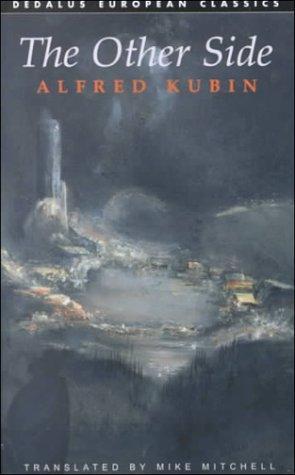 By ALFRED KUBIN (Dedalus; 1907/2000)
By ALFRED KUBIN (Dedalus; 1907/2000)
A stunning exercise in subconscious dementia that preceded Kafka and the surrealists by nearly two decades. It was the only novel by the German artist Alfred Kubin, an adherent of the fantastic and grotesque best known for illustrating the works of Poe, Hoffman and Gustav Meyrink. THE OTHER SIDE, ably translated by Mike Mitchell, recalls all of those writers, but contains an aura that’s very much unique.
The concept is a grabber: Claus Patera, a deeply eccentric, supernaturally endowed individual, creates a dream-city in a remote region of Asia. I mean this literally: the city of Pearl is a dream-based community governed by the laws of the subconscious.
The story is told from the point of view of an artist, a former colleague of Patera who is invited to live in Pearl. The artist agrees and after a lengthy journey finds himself in a perpetually murky environ—the sun never shines in Pearl—with cobbled-together retro architecture and a populace of eccentrics. The protagonist quickly finds employment as a cartoonist at the Dream Mirror, the official newspaper of Pearl. He has trouble, however, affecting a meeting with Petera, who spends his days secluded in a maze-like building.
More immediate troubles include the “Great Clock Spell” that inexplicably grips Dreamlanders, and which the artist comes to share; it refers to a mysterious spell that draws Dreamlanders into a clock tower. There’s also a psychic disturbance called the “Brainstorm” that collectively afflicts the Dreamlanders, in addition to a plethora of miscellaneous sounds and hallucinations.
But things are changing. An American man turns up in Pearl and causes enormous discord. This individual may or may not be Patera himself in a different guise, as it’s established midway through that Patera can change his facial features at will. He also psychically controls the Dreamlanders and their surrounding environment, and is evidently losing his mind.
This latter fact causes the Dream Realm to grow increasingly irrational and nightmarish. Eventually the place implodes in a riot of violence, orgies and wonton destruction, not unlike a surreal variant on THE LAST DAYS OF POMPEII. It’s in this section that the Poe connection is most evident, with the narrative overtaken by all manner of horrific grotesquerie.
But in my view the novel’s best portions come earlier, in the artist’s mundane yet baffling observations of day-to-day life in Pearl. These sections powerfully evoke the flavor of existence in this dream-country via a kind of subconscious travelogue, evoked with such astonishing imaginative vividness I couldn’t help but wonder if Alfred Kubin had actually visited this city and then reported back on what he found.
